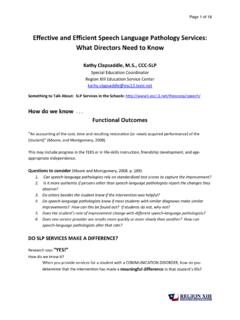Transcription of San Diego Unified School District’s Speech Improvement ...
1 San Diego Unified School District's Speech Improvement Class Summary of ASHA Presentation 11/22/08 (Session 2388). Jennifer Taps, , CCC-SLP. Senior Speech -Language Pathologist/Articulation Resource Center Coordinator e-mail: website: Facts about SIC Innovation 1 Shift to General Education Initiated in 2004-05 School year 2004 Survey 821 students on IEPs; 14 full-time SLPs Children with mild articulation errors could be any number Critical Reform Features (Staskowski & Rivera, 2005) . of sounds in error (including clusters) well-organized set of procedures (streamlined forms/flow maps).
2 Do not meet IEP criteria (In California, must meet all three buy-in from community/administration criteria 1. significant impact on intelligibility AND 2. attracts prioritizing time for SLPs (allocate up to 5 SIC students/full-time SLP). adverse attention AND 3. adverse educational impact). Innovation 2 Articulation Resource Center Ideal Candidates for SIC Coordinator - two-day assignment Around age seven - leaves years before the Speech normalization Works from central location boundary of 8;5 (Shriberg et al, 1994) (Atypical pattern exceptions Educates, models, coaches, consults about out articulation/phonological treatment lateral patterns and cluster reduction after 5;6 (Smit, 1993a; 1993b)) Provides ongoing professional development - Best Practices workshop and /r/.
3 Mild articulation errors treatment workshop each year and Phonology Conference every other year Three IEP criteria not met (documented by teacher questionnaire). Nonstimulable for target sounds (monitor/watch stimulable K/1st) Innovation 3 Evidence-Based Intervention Motivated and willing to practice at home Complexity Approach (Gierut, 2007). Phonemic (What to Teach). RtI Tiers of Intervention Language Laws Tier I Teacher/family education through PPT & conv. recasts Clusters (Gierut & Champion, 2001). Tier II Speech Improvement Class (approx. 17-20 hours) High-Frequency/Low-Density Words (Morrisette & Gierut, 2002).
4 Tier III Extended time in SIC Motor Learning Approach (Skelton, 2004). Phonetic (How to Teach It). (Mild Articulation) Three phases of motor learning 1. pre-practice/placement, 2. practice, 3. generalization Delayed feedback and self-monitoring (Strand & Kent, 2005). Randomization Lots of meaningful practice (like real communication). Monitor progress through SI Sound Inventories and conv. Samples Innovation 4 Required Home Practice Initial letter home one homework assignment not completed . courtesy call home to explain policy again and talk about moving to next child on wait list (enough to motivate most families).
5 For children with limited home support - SLP can arrange something creative for extra practice in another environment (peer buddy in class, practice in library during recess, etc.) (Hazel, 1990). Terrebonne Parish Schools- Early Intervening Services (EIS) for Speech Summary of ASHA Presentation 11/22/08 (Session 2388). Stephen Mire, MCD., CCC-SLP. Speech -Language Pathology Coordinator, Terrebonne Parish Schools e-mail: EIS Pilot Program Innovation 1 Shift to General Education 2004-05 School year General Education Children with mild articulation errors 1-2 sound errors Consultation Baseline probes of errors sounds completed Interventions for At Risk Students 2 week intervention completed by SLP prior to referral Special Education Four 30 minute small group sessions IEP Students Support Services provided by SLP up to 9 months Small group 30 minutes, twice weekly Innovation 2 EIS Services for Speech Periodic sound probes completed Prior to referral for IDEA.
6 Component of screening process Provided by SLP. Use of Intervention Data to drive referral decisions Pilot Program Results Baseline Sound Probes: 26% achieved criterion 2 week intervention: Innovation 3 Incorporating Principles of RtI for Speech 42% achieved criterion Tiered approach Support Services: Tier 1- Regular Ed only 92% achieved criterion Tier 2- At Risk-Provided by SLP. Tier 3- IEP. Progress Monitoring Projected Progress Current EIS Program Overview Generalization Probes Referral Planned and Periodic Parent Permission Analysis of Data with Program Modification Screening.
7 Data Based Decision Making Observation, interview, history, screening tests, baseline probes EIS- Intervention with progress monitoring Referral for IDEA Evaluation if indicated by data Innovation 4 Workload Based on projected treatment duration Workload Analysis Data indicating treatment duration will exceed 6 IEP Therapy Time months indicates referral EIS Time Dismissal From EIS Other Assigned Duties Communication concerns resolved Excel IEP Workload Scheduling Terrebonne Parish Schools- Early Intervening Services (EIS) for Speech Summary of ASHA Presentation 11/22/08 (Session 2388).
8 Debra Kuhn, CCC-SLP. Speech -Language Pathologist, Traverse Bay Area Intermediate School District e-mail: Speedy Speech Pilot Program Innovation 1 Shift to General Education 2005-06 School year General Education 13 At Risk Students without IEPs At Risk Students are considered and treatment Regular Ed Students provided as regular education students Short Individual Sessions Special Education 5-7 minutes a day, 3-4 days a week IEP Students 8 week intervention program Provided services at small table place in each hallway Innovation 2 Provided Services Prior to Referral for Evaluation Pilot Program Results Prior to referral for IDEA.
9 Year 1. Provided by SLP. 15% achieved goals in 8 weeks Prevent need for referral for special education 54% achieved goals in 16 weeks 31% did not achieve goals in 16 week program 1 self-corrected over the summer 3 other students continued intervention Innovation 3 Speedy Speech Service Model program the next School year. Individual Year 2. Service Intensity 19% achieved goals in 8 weeks Significantly shorter than traditional 30 minutes 69% achieved goals in 16 weeks Frequency 12% did not achieve goals in 16 week program More frequent than traditional twice weekly Duration Speedy Speech Advantages Pre-determined duration of 8 week Extensions allowed Reduction in amount of classroom instruction student is Establishes expectations for short term treatment duration missing Articulation drill more appealing due to shorter duration Increase in target repetitions 7 students seen in 40-50 minutes Easier data
10 Collection Innovation 4 Service Location Reduced time spent picking up and returning students to Services provided in hallway class Location close to classroom reduces travel time within School to pick Reduction in scheduling constraints up and return students Actual time of therapy/intervention varies each day
